
The automotive industry is undergoing a massive transformation, and at the heart of it lies the rise of electric vehicles (EVs). As we move into 2025, electric vehicles are no longer a futuristic concept—they’re becoming the mainstream. Governments are supporting clean energy policies, car manufacturers are ramping up EV production, and consumers are becoming increasingly environmentally conscious. But what exactly can we expect from EVs in 2025? This article explores key trends, innovations, and challenges that define the future of electric mobility.
1. Accelerated EV Adoption Across the Globe
The global push toward reducing carbon emissions has given EV adoption a major boost. In 2025, more countries are expected to introduce stricter emissions regulations and even announce timelines to ban internal combustion engine (ICE) vehicles.
Key Adoption Highlights:
- Europe continues to lead the way with countries like Norway and the Netherlands seeing EVs make up over 80% of new car sales.
- China, the largest EV market, is expanding its New Energy Vehicle (NEV) initiative with more affordable and advanced models.
- The United States is catching up, thanks to incentives, infrastructure investments, and automakers like Tesla, Ford, and GM heavily investing in EVs.
2. More Affordable and Accessible Models
One of the main barriers to EV adoption has been cost. However, as battery technology becomes cheaper and more efficient, 2025 will witness the release of a wide range of budget-friendly EVs.
Why EVs Will Be More Affordable:
- Battery Costs Are Dropping: The price of lithium-ion batteries has dropped by over 80% in the past decade and is expected to continue falling.
- Mass Production: Automakers are scaling production, driving economies of scale.
- Government Incentives: Tax credits, rebates, and zero-emission vehicle mandates will continue to make EVs more financially appealing.
Brands like BYD, Tata, Hyundai, and Nissan are planning to launch models under $25,000, making EVs a viable option for middle-income families.
3. Game-Changing Battery Innovations
Battery performance is the lifeblood of electric vehicles. In 2025, significant advancements in battery technology are expected to revolutionize how far, how fast, and how safely EVs can travel.
Top Battery Innovations in 2025:
- Solid-State Batteries: These promise higher energy density, faster charging, and improved safety. Toyota and BMW are leading this frontier.
- Faster Charging Times: New ultra-fast chargers and advanced battery chemistries will reduce charging time to less than 15 minutes for a 300-mile range.
- Longer Lifespan: Batteries in 2025 will last significantly longer, reducing long-term ownership costs.
4. Widespread Charging Infrastructure
The success of EVs depends heavily on the availability and convenience of charging stations. By 2025, major advancements will have improved the EV charging experience dramatically.
Charging Developments:
- Expansion of Public Charging Networks: Highways and urban centers are seeing an increase in fast-charging stations, supported by both governments and private firms.
- Home and Workplace Charging: More EV owners will have access to affordable home chargers, while businesses will install chargers for employees and customers.
- Wireless Charging: Still in early stages, but by 2025 we may see commercial applications of wireless charging pads embedded in parking lots and roadways.
5. Greater Driving Range and Performance
One of the biggest misconceptions about EVs is “range anxiety”—the fear of running out of battery power mid-journey. By 2025, this concern will significantly diminish.
Improvements You’ll See:
- Average Range: Most new EVs will offer between 300–500 miles on a single charge, covering the majority of daily and weekly driving needs.
- High-Performance EVs: Companies like Tesla, Lucid, and Rimac are producing EVs that compete with or outperform gas-powered sports cars in speed and acceleration.
- All-Weather Performance: EVs in 2025 will perform better in cold or hot weather conditions, making them practical in all climates.
6. Smarter, More Connected Vehicles
Electric vehicles are not just about electrification—they’re also about digitization. In 2025, EVs will be smarter than ever, using AI, machine learning, and cloud computing to enhance the driving experience.
Smart Features to Expect:
- Over-the-Air (OTA) Updates: Similar to smartphones, EVs will receive regular software updates to improve performance, add features, and fix bugs.
- Advanced Driver-Assistance Systems (ADAS): Lane-keeping, adaptive cruise control, and even hands-free driving on highways will be more common.
- Integrated Apps and Voice Control: Navigation, entertainment, and vehicle diagnostics will be seamlessly connected to your phone and voice assistant.
7. Environmental and Economic Benefits
With more EVs on the road, the environmental and economic benefits will become more visible in 2025.
Environmental Impact:
- Reduced Emissions: EVs produce zero tailpipe emissions, helping combat air pollution and climate change.
- Less Noise Pollution: EVs run more quietly, contributing to more peaceful urban environments.
- Recyclable Components: Advances in battery recycling will minimize the ecological footprint.
Economic Impact:
- Lower Operating Costs: Electricity is cheaper than gasoline, and EVs require less maintenance.
- New Jobs and Industries: Growth in battery production, EV maintenance, and software development is creating new employment opportunities.
8. Challenges Still Ahead
Despite the positive outlook, the EV industry will face some challenges in 2025.
Key Challenges:
- Charging Station Overload: As adoption rises, demand for chargers may outpace supply in some areas.
- Battery Material Sourcing: The supply of lithium, cobalt, and nickel must be managed responsibly to prevent environmental damage and ethical issues.
- Grid Demand: Power grids need upgrading to handle increased electricity consumption from EV charging.
Solutions like renewable energy integration, smart grid technology, and recycling programs are being developed to mitigate these concerns.
Conclusion: The Road Ahead
The electric vehicle revolution is in full swing, and 2025 marks a pivotal year. We can expect to see more affordable models, better battery technology, smarter features, and a more robust charging infrastructure. While challenges remain, the benefits—both environmental and economic—are too significant to ignore.
As EVs become the new normal, our daily commute, long road trips, and even our relationship with cars are about to change forever. Whether you’re an early adopter or just starting to consider making the switch, the future of driving is electric—and that future is now.
